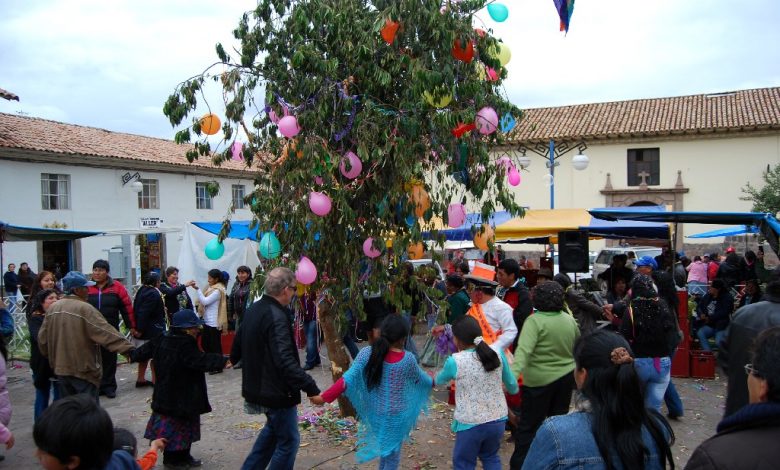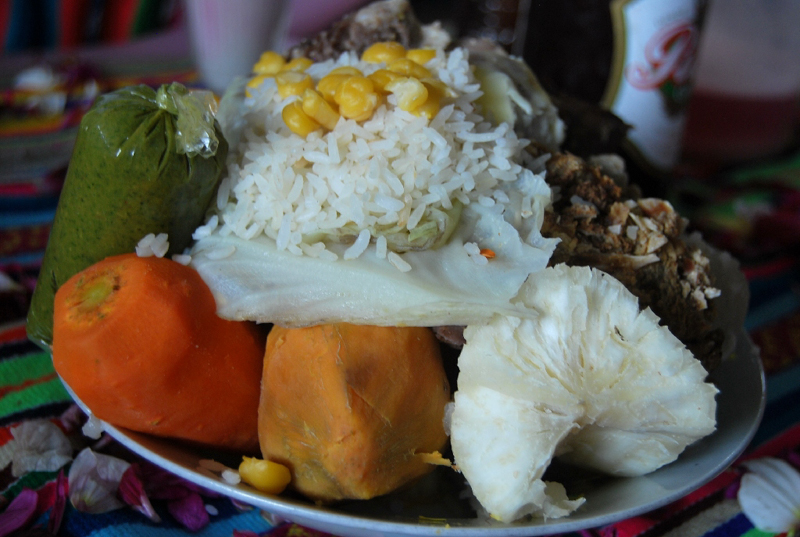Carnival Reigns in Cusco as Water Bursts Everywhere

Dancing Around the Yunza (Wayra)
Rain falls these days, a fat burst of droplets from the sky. It bounces on the ground and splashes upward, wetting plants and people. Water falls from balloons and squirt guns, or even buckets. Youths–children, teenagers, and even twenty-somethings–join with the rain. They wet the other sex, like the sky wets the ground and it splashes back.
Wind blows in gusts as the storms gather to drop their moisture. It blows and spins around houses and make the leaves of corn and potatoes vibrate in the fields as if they were dancing. People do dance, as couples–sky and earth united–spinning here and spinning there around the tall tree planted among them and covered with gifts. Their faces are covered in color, like the flowers on potatoes, broad beans, and more. They join nature in its task growing food.

The first food, new carnival potatoes soft and delicate, leaves the earth, the promise of a harvest to come that will fill larders for a dry season not far away.
As the couples spin, they chop at the tree, until it falls and people, especially children, can run to pull from it the presents it brings.
When the rains fall fat it is time to meet others and show your valor. In the countryside around Cusco this is a time of ritual battles, like outbursts of rain crossing the sky and sounding against each other. It shows us and it shows you, ever different, ever apart.
In the City, neighborhoods come together to make the feast. They have found the tree, covered it with gifts, and planted it. They have each given foods to make the communal pot, a stew, a boiled dinner called thimpu or puchero, cooked in water like the rain. This dish containing an array of foods available, joins fruit with meat, tubers with corn, and makes something whole, just as gathering its ingredients and cooking it, before serving it to all, locals and guests, identifies and creates the neighborhood as a group. One in the face of the many neighborhoods that make up the city.

Called a yunsa or yunsada, this customs is relatively new in Cusco, I am told, developing along with the neighborhoods of migrants from rural areas and other parts of Peru. Somehow this custom, originating where jungle and highlands meet in central Peru, has claimed the Imperial city and it them.
There is another tradition, a Cusco-style carnival, or city folk dressed in their classic garb, white hatted women with colorful skirts and bright shawls, dancing in couples with dark hatted, suited, men. Though it can be performed with handkerchiefs on high, and is as a representation of Cusco’s folklore, in the practice of Cusco’s people this dance of men and women as separate groups coming together in dance, twisting and spinning, sometimes separate and sometimes as a circle and then in couples, seems to have given way to the yunsada.
The more established neighborhoods of upper-middle class people and elites seem not to need a carnival dance to mark their group-ness or their identity in the face of society. They have many other means at their disposal, having let their ways become a culture for books and youtube videos, or cultural performances, something they can consume rather than something they live every year.
One notices the difference by traveling to the nearby city of Puno where the the Pandillero dance, a similar form has become a calling card of the city of Puno. Or one can go to the town of Copacabana on Lake Titicaca and watch the members of the two oldest neighborhoods, both indigenous in origin perform the Phuna celebrating their indigneity in contrast with the other neighborhoods of the town which dance one version or another of the Chuta, a dance celebrating Cholos that originated in a nearby mining town.
Carnival, though, may be most well known tot he outside world as a time of excess and inversion of social order, of party and more party. This pre-lenten feast which stands officially outside the formal calendar of the Church as a space of contrast with the holy and social and cosmic order of Christ’s passion. It is the ground in which lent with its seriousness and organization makes sense.
Of course, even in the craziness of parties or the danger of carnival, the order of organized dance groups and parade groups stands out. They give order, passion, and system even when the sacred order takes a break to form a ground on which its salvific passion can take place.

These groups, the yunsas, and the passionate play with water of unmarried youth arranged in roaming groups of friends threatening all with their bursts of water, or even spray and colored flour, stand out and maintain social order when the Church is occupied in preparing for its dry period of fasting and reflection. In the Andes, Carnival does not end with Ash Wednesday, it bridges over this tolling moment with dance, music, color and food.
This is even more meaningful these days as the Church faces threats to its primacy, from Evangelical groups and from civic order which forces it into a kind of constrained limits and opposition to contrast to the ordinariness of the secular. Its ties to society as a prop, a guarantee are being challenged. But society is not. It continues.
Next Sunday, Carnival will finish with a storm of activity in what is called the cacharpari (leave taking) and normal social order takes over from the power and playful intensity of this feast and celebration.
The rains will still fall for another while, but the city and surrounding area now begins its preparations for Holy Week with its pilgrimage to the high glacier and Christ of Qoyllurrit’i, and the very holy day when the Lord of Temblors makes his annual procession through the streets of the city and all its people leave their neighborhoods to come to the Plaza to receive his blessing.





